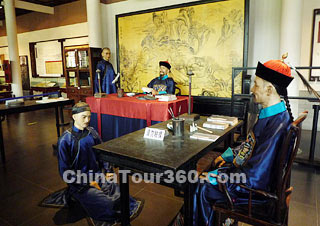
Manchu People of the Qing Dynasty
The Manchu, with a population of 10,682,263 (in 2000), are mainly distributed in Liaoning, Jilin and Heilongjiang provinces, of which Liaoning has the most Manchus.
Manchu history can be traced back to the Sushen people who lived 2,000 years ago. They were the earliest ancestors of the Manchu. In the Liao, Song, Yuan and Ming dynasties, they were called Nüchen. At the end of the 16th century, with the appearance of Nurhachi, the tribes of Nüchen were unified and a new nationality - Manchu - came into being, consisting of Nüchens, Hans, Mongolians and Koreans. With the founding of the Qing Dynasty in 1644, the Manchu reached its golden age.
Most Manchu are engaged in agricultural-related jobs. Their main crops include soybean, sorghum, corn, millet, tobacco and apple. They also raise silkworms.
Manchu has its own language and letters, which belong to the Manchu-Tungusic group of the Altaic language family. Manchu letters were created in the 16th century on the base of Mongolian letters. With more and more Manchus settling in the Central Plains since the Qing Dynasty, the economic and cultural exchange between Hans and Manchus became more and more frequent and the Manchus gradually adopted the Han language.
The Manchus like to eat millet. Their festivals were traditionally celebrated with dumplings, and, on New Year's Eve, with a treat of stewed meat. Boiled and roast pork and Manchu-style cookies were table delicacies. As a kind of royal food, the Manchu snack 'Saqima' (a kind of candied fritter) now is welcomed by other nationalities.
The traditional costumes of a Manchu man are a narrow-cuffed short jacket over a long gown with a belt at the waist to facilitate horse-riding and hunting. Women used to wear loose-bodied Cheongsams and embroidered shoes or pattens. In past times, men wore their hair long. They braided their hair and let the braids droop behind their heads. Women coiled their hair on top of their heads and wore earrings and headgear.
Manchu women didn't need to suffer from footbinding. Manchus is striped-pants in formality. In the past days, the junior would send their formal regards to the eldership every day. In greeting their superiors, men were required to extend their left hand to the knee and idle the right hand while scraping a bow, and women would squat with both hands on the knees. Embracing the waist and touching faces were regarded as the necessary behaviors when relatives or friends met. Kowtow is one of the formal salutes of Manchu. On the occasions of a wedding ceremony, funeral or facing emperor or officials, kowtow would be sent.
The Manchus have different beliefs. Most of the Manchus believe in Shamanism. Thinking that there are many gods commanding the world, they also worship the Big Dipper, their ancestors and nature such as forests and mountains.
Manchu and Han basically share the same festivals and holidays, although there are still some differences in respect to celebrating ceremonies.
Regarding taboos, killing and eating dog meat is forbidden to Manchus.







